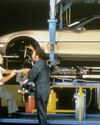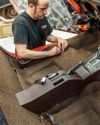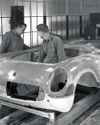
For nearly three decades, St. Louis was Corvette’s birthplace. Some 695,214 Corvettes were produced there between 1954 and 1981. The manufacture of Corvettes at St. Louis was never simple for General Motors. Ongoing labor tensions, plant conditions, increasing environmental legislation and quality issues haunted the Corvette for a long time.
In the 1970s, GM understood the Corvette needed to be produced in a state-of-the-art assembly plant with modern technology to keep the car competitive. GM also needed labour-friendly conditions it was never going to have in St. Louis. By the late 1970s, it was time for a fresh-face Corvette, along with vastly improved quality, fit and finish. It was announced in March 1979 that GM would close St. Louis and move Corvette production to a shuttered Chrysler air conditioning plant in Bowling Green, Kentucky.
Bowling Green produced its first Corvette, a C3 1982 two-tone coupe, on June 1, 1981, during a two-month period when production overlapped with St. Louis. St. Louis would buck and build its last Corvette on July 31, 1981. Job 1 Bowling Green was proof positive GM knew how to move quickly and produce a good product in short order. Because there were a lot of development issues surrounding the all-new C4 Corvette scheduled for production at Bowling Green, production of these cars was pushed back to June 1, 1983 where they would be produced and sold as 1984 models.
This story is from the March 2020 edition of Vette.
Start your 7-day Magzter GOLD free trial to access thousands of curated premium stories, and 8,500+ magazines and newspapers.
Already a subscriber ? Sign In
This story is from the March 2020 edition of Vette.
Start your 7-day Magzter GOLD free trial to access thousands of curated premium stories, and 8,500+ magazines and newspapers.
Already a subscriber? Sign In

When Originality Is The Problem, Restomod Is The Solution
An artistic amalgamation that blends modern upgrades with classic lines

Building America's Sports Car
When nearly three decades of production ended at St. Louis, Corvette assembly went high-tech in rural Kentucky

COMING FULL CIRCLE
Young man’s hot rod passed down to another young hot rodder

From the Archives
Bred to Race

It's All About The Base!
The standard C8 coupe offers a robust foundation to enable you to build your own special 2020 Corvette

Supersonic
David Gonce’s 1979 Corvette packs plenty of attitude

2019 CORVETTES AT CARLISLE
Fueled by the C8 Corvette, the Corvettes at Carlisle show set a new attendance record in 2019

Rug Doctor
Fresh carpet brings new life to our 1968 Corvette project car

Form And Function
No compromise needed

Building America's Sports Car
Three Corvette assembly plants and a look back at 67 years of production of one red-hot all-American sports car